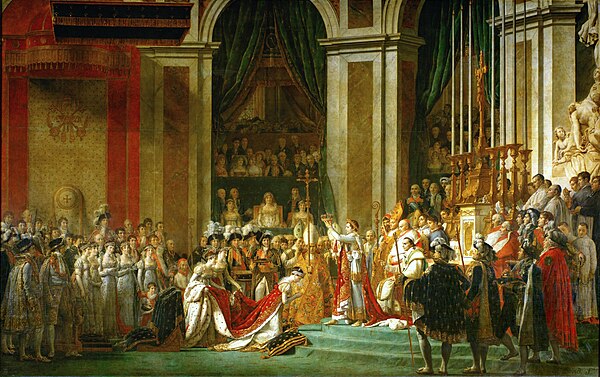
What is the purpose of the coronation of Napoleon painting?
The “Coronation of Napoleon” is one of the most iconic works of art from the early 19th century. Painted by Jacques Louis David between 1805 and 1807, the monumental artwork captures the coronation ceremony of Napoleon Bonaparte as Emperor of the French, held on December 2, 1804, at the Notre-Dame Cathedral in Paris. This painting, officially titled Le Sacre de Napoléon, was commissioned by Napoleon himself to immortalize this historic moment. Its purpose extends far beyond the aesthetic; it serves as a political statement, a tool of propaganda, and a reflection of the changing socio-political landscape of Europe at the time. In this discussion, we will explore the multi-faceted purposes of the “Coronation of Napoleon,” analyzing its historical context, symbolism, and lasting impact on art and culture.
Historical Context
The coronation of Napoleon marked a turning point in European history. Rising from humble beginnings as a Corsican military officer, Napoleon ascended to the highest echelons of power during the turbulent years of the French Revolution. By 1804, he had solidified his position as First Consul of France and sought to legitimize his rule by crowning himself Emperor. This act not only signified a break from the republican ideals of the Revolution but also challenged the traditional authority of monarchs and the Catholic Church.
Jacques-Louis David, a leading painter of the Neoclassical movement and a fervent supporter of the Revolution, was commissioned to document this momentous occasion. His task was to create a visual narrative that conveyed the grandeur, authority, and legitimacy of Napoleon’s reign while also addressing the ideological shifts of the era.
Political Propaganda
At its core, the “Coronation of Napoleon” is a masterful work of propaganda. Every element of the painting was carefully orchestrated to reinforce Napoleon’s power and authority. One of the most striking aspects of the coronation was Napoleon’s decision to crown himself, a departure from the traditional practice where the Pope would place the crown on a monarch’s head. This act symbolized Napoleon’s belief that his authority derived from his own achievements and the will of the people, rather than divine right or the Church.
David’s painting captures this moment indirectly. Instead of showing Napoleon placing the crown on his own head, the painting depicts him crowning Josephine, his wife, as Empress. This choice shifts the focus from Napoleon’s self-aggrandizement to the unity and sanctity of the imperial couple. By doing so, David presents Napoleon as a magnanimous leader who shares his power and honors traditional marital bonds.
The inclusion of Pope Pius VII in the composition is another strategic decision. Although the Pope’s role in the ceremony was largely ceremonial, his presence in the painting lends religious legitimacy to the event. Interestingly, David portrays the Pope with his hand raised in a gesture of blessing, even though historical accounts suggest that Pius VII was reluctant and largely passive during the coronation. This subtle alteration underscores Napoleon’s ability to manipulate religious imagery to bolster his own authority.
Symbolism and Composition
The “Coronation of Napoleon” is rich with symbolic elements that convey messages about power, legitimacy, and continuity. The composition is meticulously arranged to draw the viewer’s eye toward Napoleon, who stands at the center of the scene, illuminated by soft, golden light. His pose exudes confidence and command, emphasizing his role as the central figure in this new era of French history.
Surrounding Napoleon are various figures, each carefully chosen to represent different facets of his rule. Josephine’s presence highlights the dynastic aspirations of the Bonaparte family, while members of the imperial court and military underscore Napoleon’s broad base of support. The inclusion of prominent figures from the Revolution, such as Jean-Baptiste Bernadotte and Charles-François Lebrun, signals Napoleon’s efforts to reconcile revolutionary ideals with the restored grandeur of the empire.
The Notre-Dame Cathedral itself serves as a symbol of tradition and continuity. By choosing this historic venue for his coronation, Napoleon aligns himself with the legacy of French monarchs, even as he seeks to redefine what it means to rule. The Gothic architecture, meticulously rendered by David, provides a dramatic backdrop that reinforces the solemnity and significance of the occasion.
Artistic Significance
From an artistic perspective, the “Coronation of Napoleon” is a masterpiece of Neoclassical art. David’s meticulous attention to detail, balanced composition, and mastery of color and light create a sense of grandeur and permanence. The painting’s monumental scale—it measures over 6 meters tall and 9.79 meters wide, adds to its imposing presence, making it impossible for viewers to ignore.
David’s use of Neoclassical aesthetics serves a dual purpose. On one hand, it evokes the grandeur of ancient Roman and Greek art, linking Napoleon’s rule to the great empires of the past. On the other hand, it provides a sense of clarity and order, reflecting the Enlightenment ideals of reason and progress. This blend of historical and contemporary elements makes the painting a powerful statement about Napoleon’s vision for France.
Cultural and Historical Legacy
The “Coronation of Napoleon” has left a lasting impact on both art and history. As a visual record of one of the most significant events of the Napoleonic era, it provides invaluable insights into the politics, culture, and symbolism of the time. The painting also set a precedent for how rulers could use art to shape their public image and legitimize their authority.
In the years following its creation, the “Coronation of Napoleon” was displayed in the Louvre, where it became a centerpiece of French national identity. Even after Napoleon’s fall from power, the painting continued to be admired for its artistic merits and historical significance. Today, it remains one of the most celebrated works in the Louvre’s collection, attracting millions of visitors from around the world.
The “Coronation of Napoleon” is far more than a mere depiction of a historical event. It is a carefully constructed narrative that serves multiple purposes: to legitimize Napoleon’s rule, glorify his achievements, and convey the grandeur of the Napoleonic Empire. Through its masterful composition, rich symbolism, and historical context, the painting provides a window into the complexities of power and propaganda in the early 19th century. Jacques-Louis David’s masterpiece continues to resonate with audiences today, reminding us of the enduring power of art to shape our understanding of history and identity.




